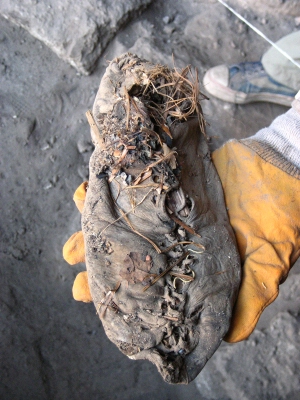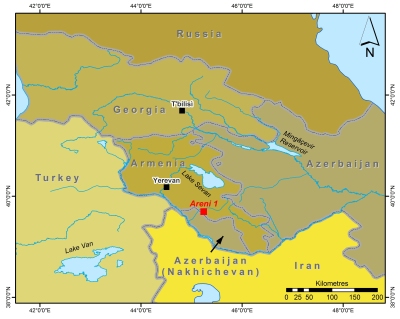
Believed to be the oldest leather shoe ever discovered, the find dates back to around 3,500 B.C. and was announced today (June 9) in the online scientific journal PLoS ONE.
"Generally, organic materials are poorly preserved in Middle Eastern archaeological sites because of the high content of salts and fungi in the soil and dramatic fluctuations in the temperatures and humidity in the weather," said Gregory Areshian, a visiting associate professor at the Cotsen who was nearby when the discovery was made. "But the condition of this shoe is amazing."
Made of a single piece of cowhide, the shoe was shaped to fit the wearer's foot and was stuffed with grass. Archaeologists aren't sure whether the grass was used as insulation or - as a possible precursor to the modern shoe tree - to maintain the shape of the shoe. They also don't know whether the shoe - the equivalent of a European size 37 or an American women's size 7 - belonged to a male or female.
"While small, the shoe could well have fit a man from that era," said Ron Pinhasi, the study's lead author and a lecturer in archaeology at the University College Cork in Cork, Ireland.
The discovery was made in Armenia's Vayotz Dzor province, on the country's border with Iran and Turkey. The cave's stable, cool and dry conditions are credited with the exceptional condition of the various objects that were found there, including large containers, many of which held well-preserved wheat and barley, apricots and other edible plants. The preservation was also helped by the fact that the floor of the cave was covered by a thick layer of sheep dung, which acted as a solid seal over the objects.

The shoe was discovered by Diana Zardaryan, a graduate student at the Institute of Archaeology, Armenia, in a pit that also included a broken pot and wild goat horns. "I was amazed to find that even the shoelaces were preserved," she recalled.
While the Armenian discovery is believed to be the oldest example of enclosed footwear made of leather, a pair of leather sandals and a single moccasin made of plant material by American Indians remain the oldest known footwear to date. Predating the Armenian shoe by as many as 2,000 years, the American Indian footwear was discovered in the 1970s in a cave in Missouri. Another pair of leather sandals that have been dated to the same era as the Armenian shoe was found in Israel's Judean Desert in 1993.

But the researchers are more certain of the age of the Armenian shoe than scholars are of the two other sets of footwear. Strips of leather taken from the Armenian shoe were dated independently of each other in labs at the University of Oxford and the University of California, Irvine. The older footwear was not directly dated; the age of those finds was based on various other associated artifacts.
Interestingly, the Armenian shoe is very similar to the "pampooties" worn in the Aran Islands on Ireland's west coast up to the 1950s, said Pinhasi. "In fact, enormous similarities exist between the manufacturing technique and style of the [Armenian] shoe and those found across Europe at later periods, suggesting that this type of shoe was worn for thousands of years across a large and environmentally diverse region."



Reader Comments
to our Newsletter